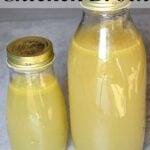This post may contain affiliate links. Please read our disclosure policy.
How to make chicken broth with whole raw chicken/chicken pieces. It’s light, versatile, and packed with flavor – perfect for enjoying alone as a pick-me-up or as the base for soups, stews, sauces, and with grains!
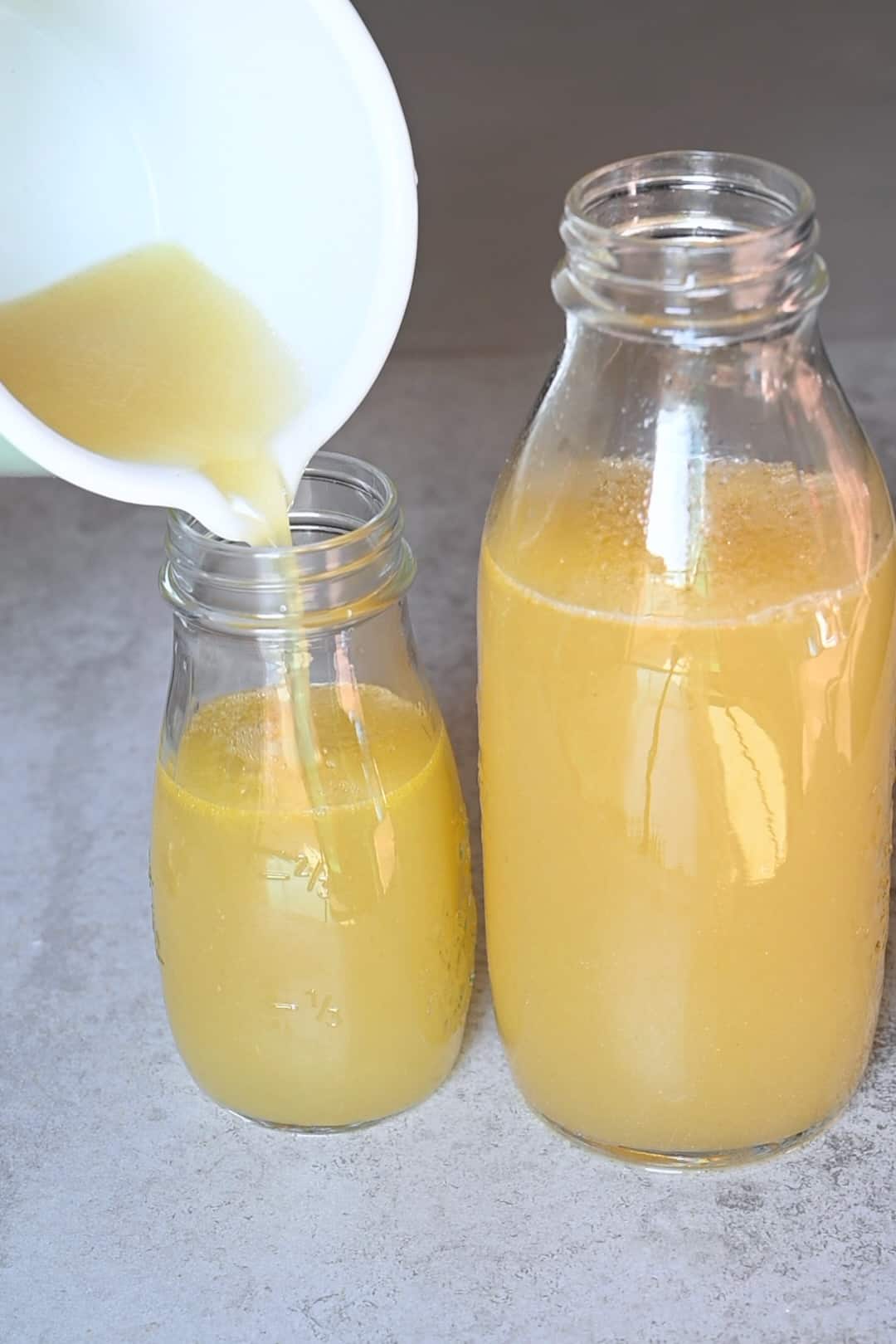
Having already shared homemade methods for vegetable stock and bouillon cubes, it’s time to complete the collection with chicken broth and stock from scratch. These kitchen basics are something I highly recommend all home cooks try at some point.
This homemade chicken broth recipe is easy to prepare and versatile (with different flavoring options that you can tweak). It can also be salted to your liking and tastes miles better than store-bought options. Plus it is healthier and less expensive and is ready in as little as an hour.
Plus, you get a delicious DIY chicken broth that you can refrigerate or freeze. And this method will also leave you with perfectly poached chicken, and veggies ready to puree into soups and sauces. Nothing goes to waste!
Want to save this recipe?
What is chicken broth
Chicken broth is a liquid prepared by simmering the meat from chicken, often along with other vegetables and herbs, for a short time (to avoid overcooking the meat). The purpose is to create a flavorful broth to use as a base for soups, sauces, and stews. It’s also a popular, comforting source of nutrition for those who are feeling sick.
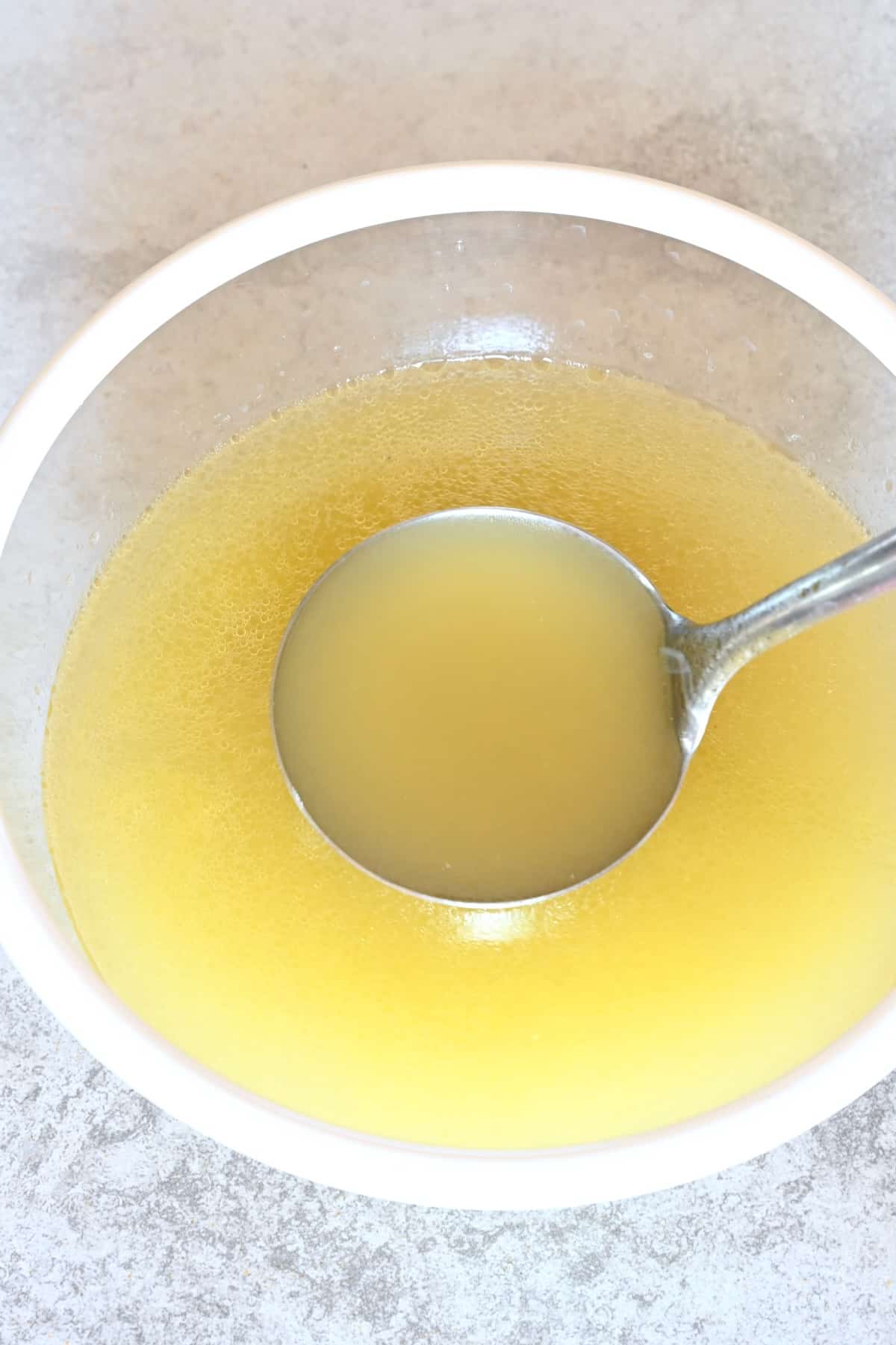
Is chicken broth the same as chicken bouillon?
Technically speaking, bouillon is the French word for broth; the two are the same. However, bouillon is also the name used to refer to dry products like bouillon powder and bouillon cubes. These are forms of broth that are condensed and dehydrated that you can dilute with water to make up a broth. Or you can add to various gravies and sauces in small amounts for extra flavor.
What is the difference between chicken broth and chicken stock?
Though the terms are sometimes used interchangeably, the two aren’t technically the same. For example, chicken broth simmers whole chicken or chicken pieces (meat included) in water, usually for an hour or less. In comparison, homemade chicken stock simmers primarily chicken bones in water for hours at a time, slowly, to break down the bones/marrow and the gelatin within.
As a result, chicken broth is quicker and easier to make. It produces a lighter, thinner liquid with a milder flavor (often seasoned so it can be consumed alone). In contrast, chicken stock is a richer, thicker, usually more gelatinous liquid with a darker color, and more concentrated flavor.
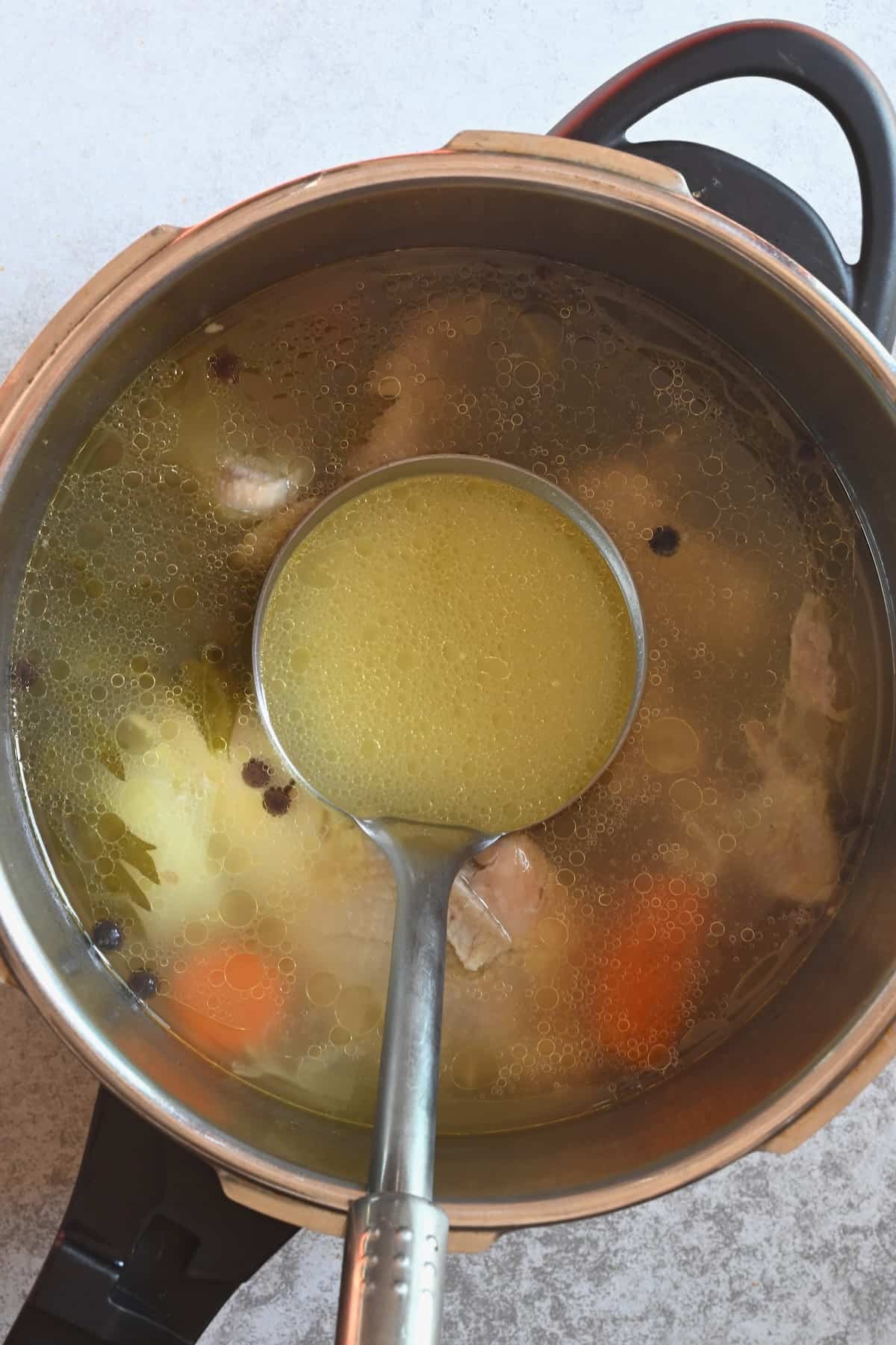
Is chicken broth good for you
Chicken broth doesn’t contain as many nutrients as stock. But it’s still a delicious and healthy ingredient when made at home (i.e., not packed with sodium). The benefits of drinking chicken broth include improving digestive and gut health and clearing congestion. It also soothes the throat (perfect for colds and the flu) and contains several nutrients.
What is chicken broth made of
There are a few simple ingredients in chicken broth.
- Chicken: For this recipe for chicken broth from scratch, I’ve used a whole chicken, cut into smaller pieces, with the giblets removed. Otherwise, use bone-in, skin-on chicken pieces as well as chicken carcasses.
Note: The amount of chicken you use changes how “rich” the final broth is. I recommend around 6 lb chicken to 16-18 cups water for lighter results. Or increase the chicken by 50-100% for a richer stock.
- Vegetables: I use a fairly typical “base mix” to add tons of flavor and make the best chicken broth recipe:
- Onion,
- Carrot,
- Celery,
- Garlic,
- Ginger (optional).
- Herbs/Spices: To create a full-bodied chicken bone broth, I used:
- Parsley stems,
- Sprig of fresh thyme or rosemary (or 50/50 of both),
- Bay leaf,
- Whole black peppercorns
- Salt (optional – or soy sauce for more umami flavor and darker color)
- Water: To make up the base of the chicken broth recipe.
If you want a basic chicken broth, use only bay leaves, salt, and pepper.
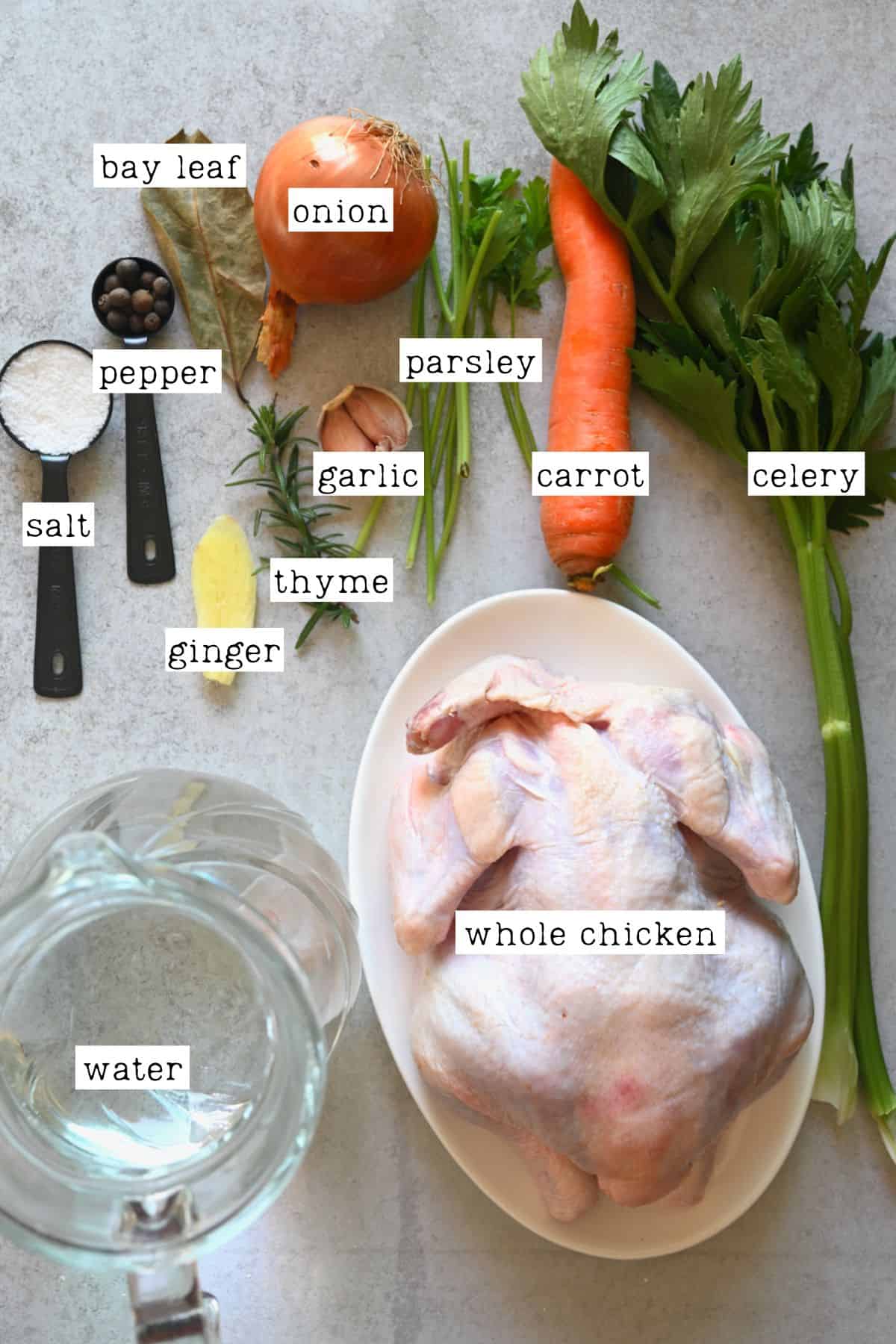
How to make chicken broth
Making chicken broth from scratch is a simple process and requires just a few simple steps.
Step 1: Prep the ingredients
First, if you’ve purchased a whole chicken, cut it down into smaller pieces, removing the giblets.
Next, prepare the vegetables by rinsing the carrot and celery, then roughly chop them. Peel and halve the onion, and peel the garlic and ginger.
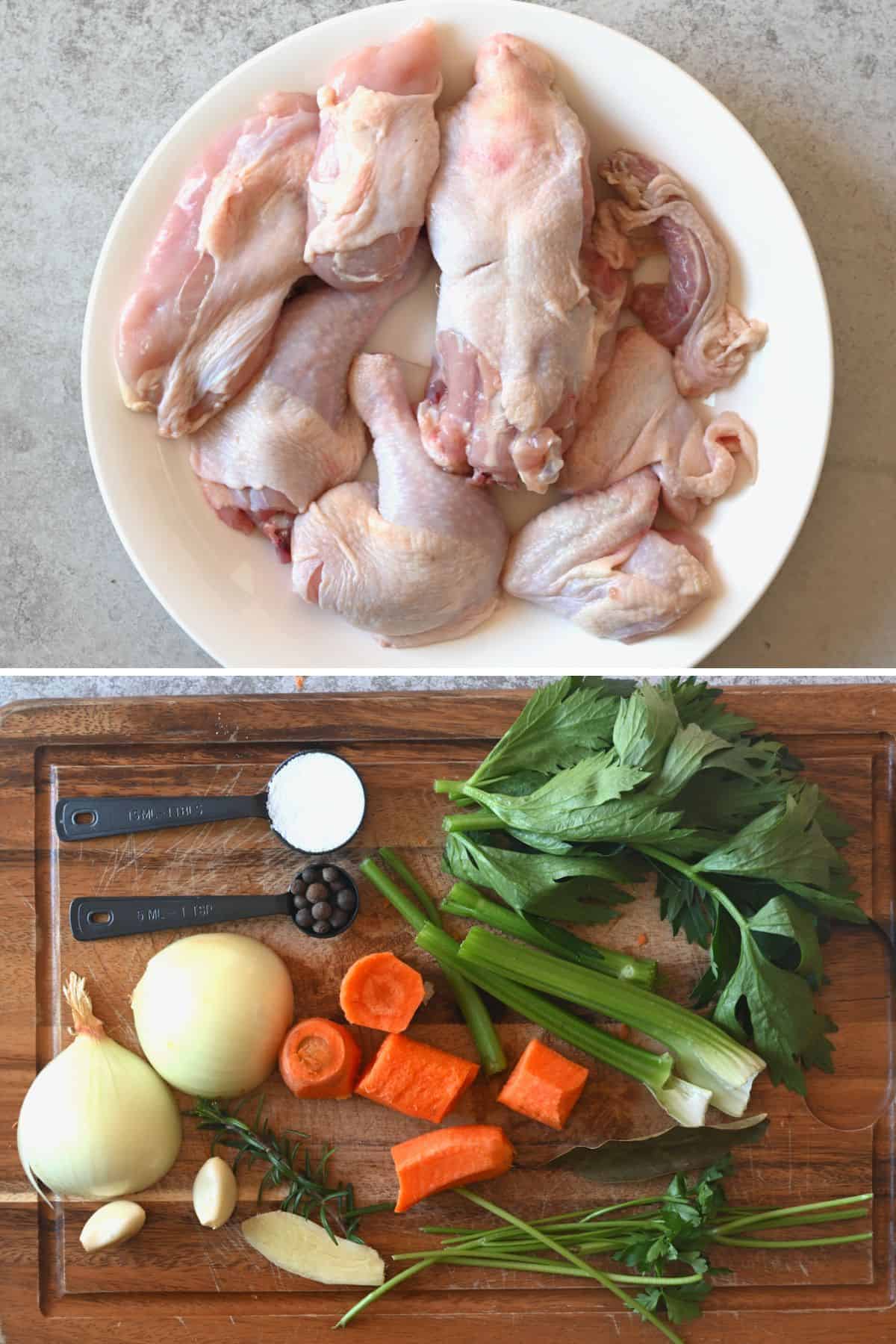
Step 2: Bring to a boil
In a heavy-based, large stock pot, add the chicken and enough cold water to cover it. (Don’t add too much, or you’ll dilute the broth flavor). Bring the water to a boil over medium-high heat, then immediately reduce the heat to low. Skim off any foam “scum” that forms at the top of the liquid with a spoon/skimmer.
For more flavor, you can sauté the chicken pieces first (like the wings, back, etc.) until browned to lock in more flavor.
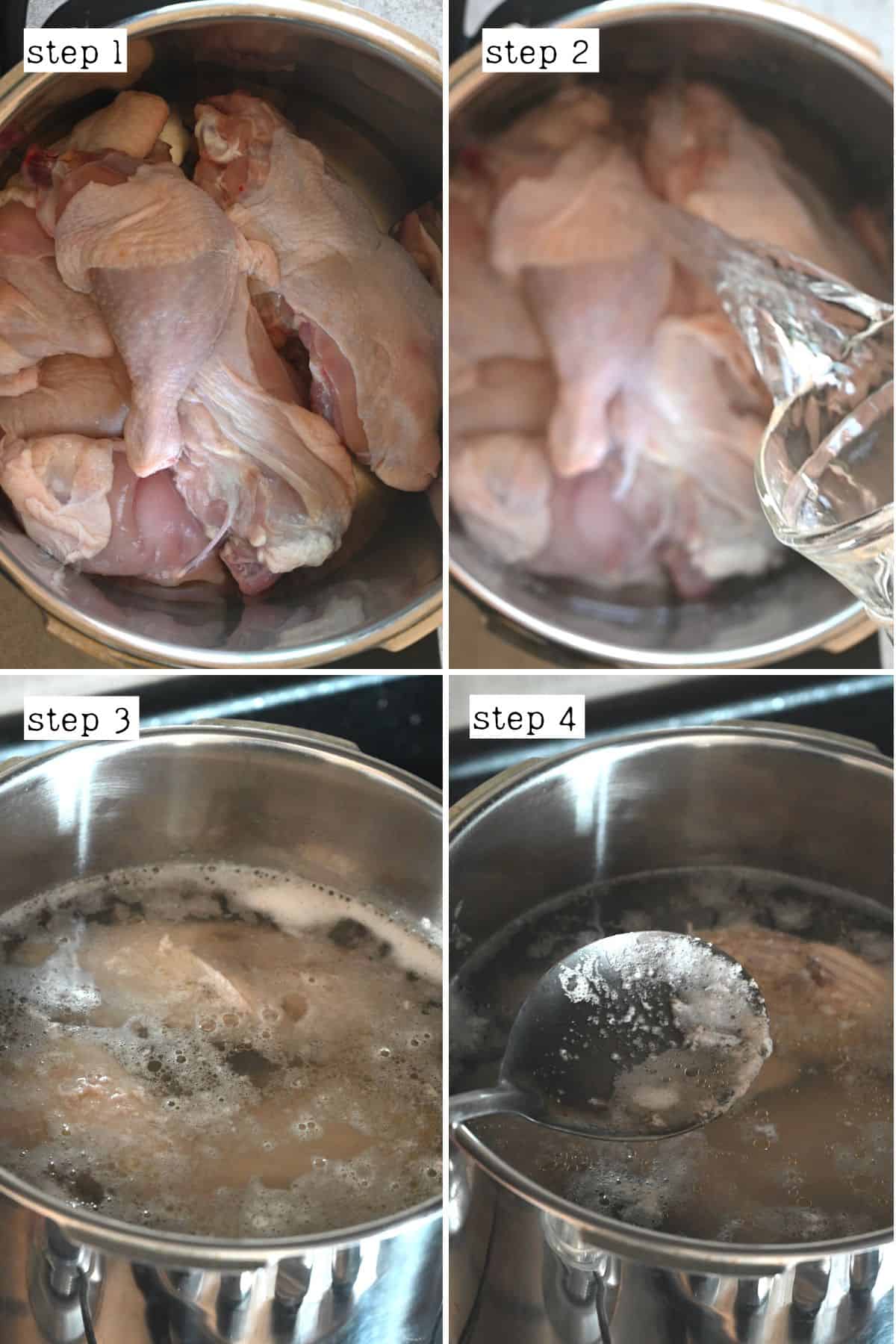
Step 3: Simmer
Then, add all the remaining ingredients (except salt) and cover with a lid. Allow it to simmer gently for at least an hour or until the chicken cooks through, and the liquid infuses with flavor.
If you want more flavor, remove the solids (cooked meat and veggies), then continue to simmer for up to 3 hours. After that, you can return the bones to the pan if preferred.
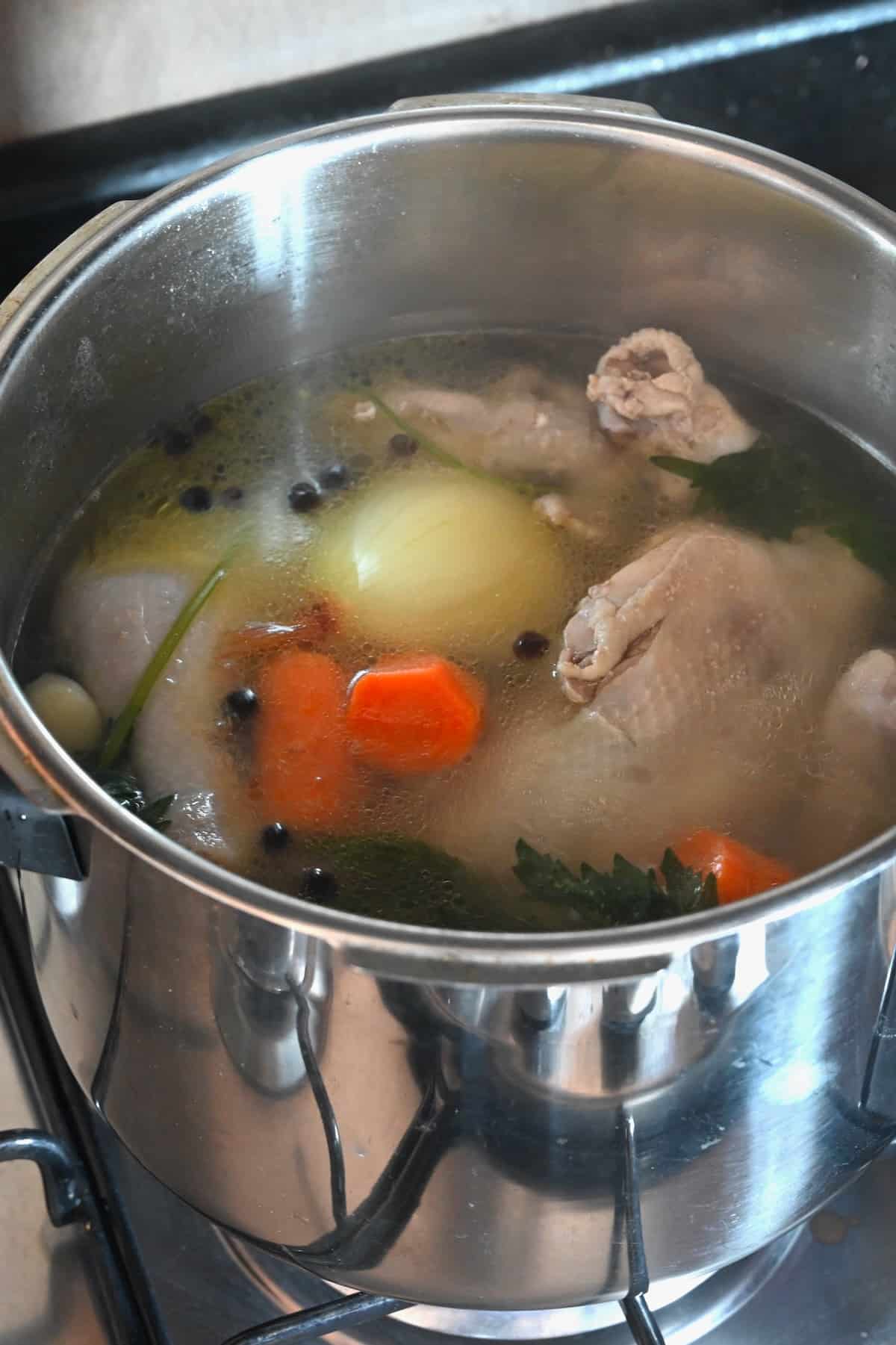
Finally, strain the broth through a fine-mesh strainer into a large bowl. Add salt (if using) and allow it to cool before transferring it to the fridge.
When left to chill overnight, any fat will solidify at the top. It’s easy to scoop out if preferred (and use as cooking fat).
Then decant the broth into bottles/jars.
To make clear chicken broth
There are several ways you can ensure a clearer, less cloudy broth.
- First, don’t allow it to boil, and remove any foamy “scum” from the top of the pot as it appears.
- Alternatively, you can first blanch the chicken to remove impurities. To do so, boil the chicken for 4-5 minutes, discard the water, replace it with clean water, and follow the recipe.
- Drain the broth through several layers of cheesecloth to catch fine particles.
- Lastly, you can clarify the broth with egg white to trap fine particles (then strain it through cheesecloth).
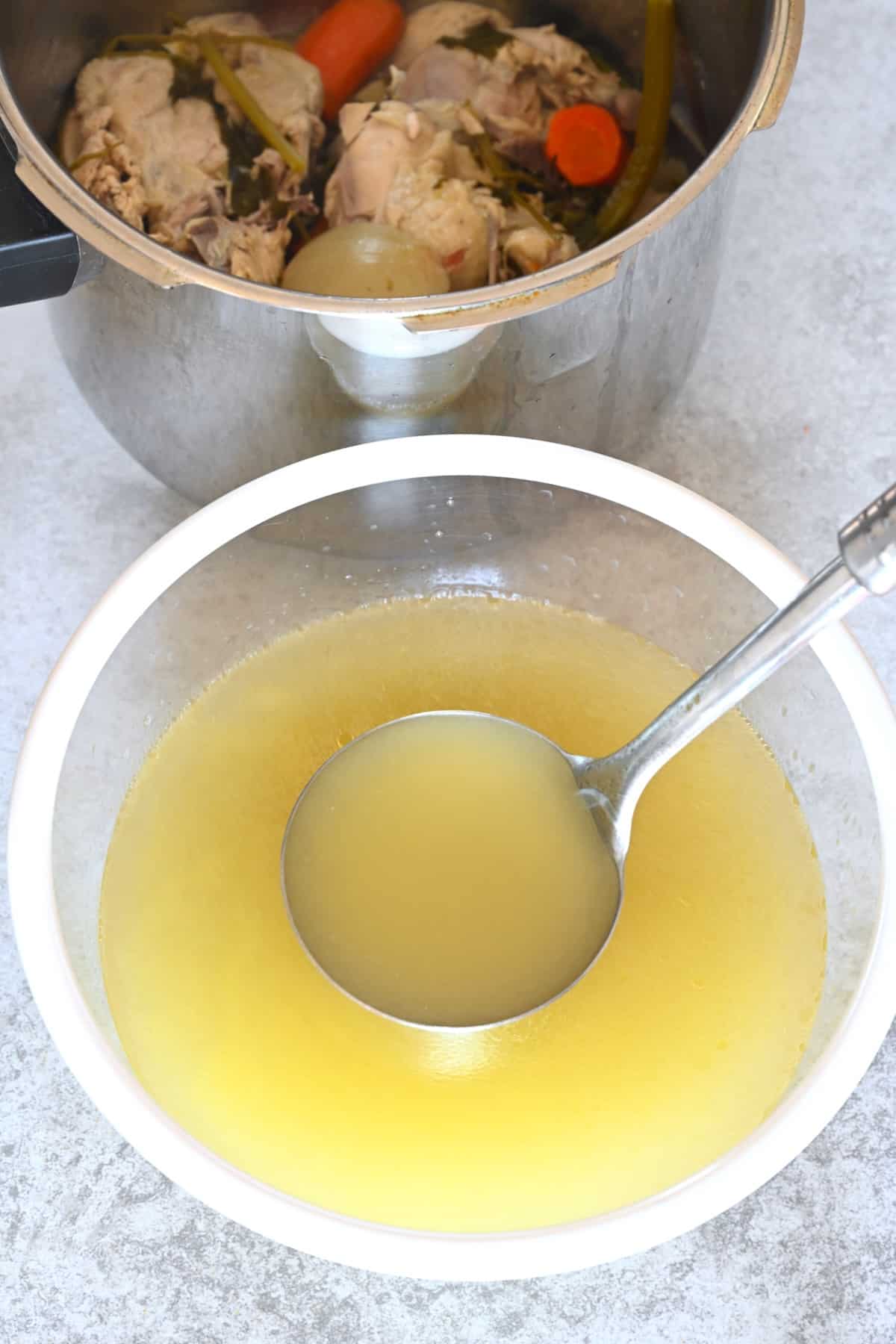
How long does chicken broth last in the fridge
You can store the mason jars of homemade chicken broth in the refrigerator for 5-6 days.
How to can chicken broth
To safely can chicken broth, you need to use a pressure canner, not a water bath canner. Guidelines recommend processing at 10 pounds of pressure at 1000 ft (increase based on altitude). The processing time is 20 minutes for pint jars or 25 minutes for quart jars. Check the website for Home Food Preservation for more tips about timing and altitude.
How to use chicken broth
Chicken broth is a kitchen essential to be used in dozens of ways:
- As a base for stew and soup recipes, perfect for homemade cream of chicken soup,
- Use in casseroles,
- Cooking grains and pulses to add more flavor – rice, pasta, quinoa, & risotto,
- To cook polenta or savory oatmeal,
- To add flavor to sauces and gravies,
- To drink alone, as a simple chicken broth soup, and to make chicken noodle soup.
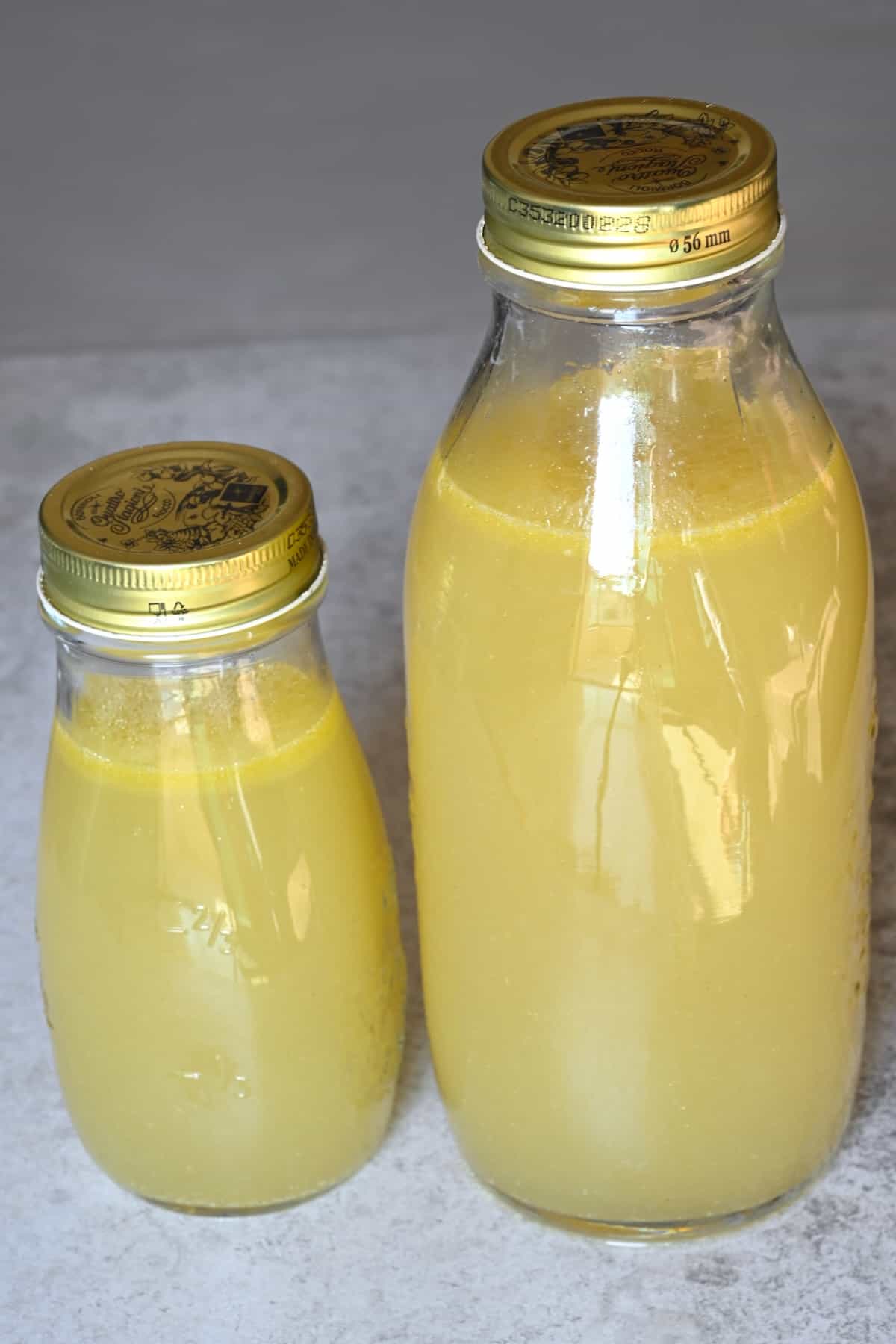
FAQs
It’s not necessary, but it can help to remove impurities from the chicken, so you end up with a clearer broth. Just note that you’ll also lose out on some broth flavor, though, when using this method.
Depending on the recipe/planned usage, you could use chicken stock, chicken bouillon cubes, powder, or granules (diluted with water). Or you can even substitute it for another broth, like vegetable broth or beef broth.
It is a soothing, warm, and delicious option when you feel ill.
This chicken broth recipe produces broth delicious enough to consume on its own. But I love adding something acidic (apple cider vinegar or lemon juice) for brightness and flavor depth. You can also season it to your liking with salt and pepper.
Stock is generally healthier than broth, with a richer flavor and texture. It has more protein, carbs, and fat, plus higher levels of vitamins and minerals. On the other hand, the broth is lower in calories and still very flavorful.
Chicken bouillon cubes are simply dried chicken broth. So to make liquid broth, add one cube to a cup of hot water and let it dissolve. Then use it in recipes that use chicken broth.
Add all the ingredients and cook on LOW or between 8-10 hours, straining out the solids at the end.
More chicken DIYs
- Chicken Brine Recipe
- How to Cut Chicken Wings
- The Best Air Fryer Chicken Drumsticks
- Frozen Chicken Tenders in Air Fryer
- Crispy Air Fryer Chicken Thighs 2 Ways
- Easy Oven-Baked Boneless Chicken Thighs
- The Perfect Whole Roasted Chicken
If you try this recipe for homemade chicken broth, let me know how it goes in the comments below. I’d appreciate a recipe card rating and would love to see your recipe recreations – tag me on Instagram @Alphafoodie!
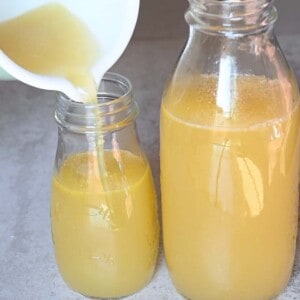
How To Make Chicken Broth
Ingredients
- 42 oz chicken 1 whole, giblets removed OR similar weight chicken pieces (bone in skin on)
- 12 cups water needs to cover the chicken and veggies
- 5.6 oz onion 1 large
- 4.1 oz carrot 1 large
- 1.4 oz celery 2 stalks
- 0.2 oz parsley a few stems
- 0.17 oz fresh ginger a small piece
- 1 sprig thyme or rosemary
- 0.32 oz garlic 2 cloves
- 1 bay leaf large
- 1 tsp whole black peppercorns
- 1 Tbsp salt optional
Instructions
- If you've purchased a whole chicken, cut it down into smaller pieces, removing the giblets.
- Prepare the vegetables by rinsing the carrot and celery, then roughly chop them. Peel and halve the onion, and peel the garlic and ginger.
- In a heavy-based, large stock pot, add the chicken and enough cold water to cover it (don't add too much, or you'll dilute the broth flavor). Bring the water to a boil over medium-high heat, then immediately reduce heat to low, skimming off any foam "scum" that forms at the top of the liquid with a spoon/skimmer.For more flavor, you can sauté the chicken pieces first (like the wings, back, etc.) until browned to lock in more flavor.
- Add all the remaining ingredients (except salt) and cover the pot with a lid. Allow it to simmer gently for at least an hour or until the chicken cooks through, and the liquid infuses with flavor.If you want more flavor, remove the solids (cooked meat and veggies), then continue to simmer for up to 3 hours. After that, you can return the bones to the pan if preferred.
- Strain the broth through a fine-mesh strainer into a large bowl, add salt (if using), and allow it to cool before transferring it to the fridge. When left to chill overnight, any accumulated fat will solidify at the top, easy to scoop out if preferred (and use as cooking fat). Then decant the broth into bottles/jars.
Storage Instructions
- Fridge: You can store the mason jars of homemade chicken broth in the refrigerator for 5-6 days.Freezer: Pour the cooled broth into several freezer-safe jars, leaving at least 1-inch headspace (for expansion as it freezes) OR in an XL ice-cube tray to freeze, then transfer to Ziplock. Then store it in the freezer for 3 months. Allow it to thaw in the fridge overnight before reheating.Reheat: Reheat the homemade chicken broth either on the stove, in the microwave, or by adding it directly to your dish (soup, stew, etc.) to heat.
Notes
- For a more flavorful broth: Remove the meat when it’s cooked (breasts take between 40-60 minutes, darker meat can take longer) and continue to simmer the bones to your desired flavor.
- For concentrated broth: After straining the solids, continue to simmer the mixture to reduce the liquid into a concentrated version (sometimes for a further 1-2 hours) that takes up less storage space.
- Experiment with flavorings: I.e., veggies, herbs, spices, etc.I recommend making notes every time you add new ingredients/change ratios of veggies, herbs, etc. That way, you’ll be able to replicate your favorite versions easily.
- Use the leftover solids: Veggies removed at the hour mark will still work in pureed soups and sauces (too long, and they can become bitter). Meanwhile, the chicken should be poached and usable in many ways.
- First, don’t allow it to boil, and remove any foamy ‘scum’ from the top of the pot as it appears.
- Alternatively, you can first blanch the chicken to remove impurities. To do so, boil the chicken for 4-5 minutes, discard the water, replace it with clean water, and follow the recipe.
- Drain the broth through several layers of cheesecloth to catch fine particles.
- Lastly, you can clarify the chicken broth with egg white to trap fine particles (then strain it through cheesecloth).
Nutrition
Nutrition information is automatically calculated, so should only be used as an approximation.



